2015 Gulf Guardian Award Winners
On This Page:
About the Gulf Guardian Awards
The Gulf of Mexico Program Partnership developed the Gulf Guardian awards as a way to recognize and honor the businesses, community groups, individuals, and agencies that are taking positive steps to keep the Gulf healthy, beautiful and productive. The Gulf Guardian Award exemplifies what the Gulf of Mexico Program is all about: innovative solutions that come about when we pool resources and look for creative ways to positively impact our quality of life and economic well being.
The first Gulf Guardian Award winners were recognized in 2000. Every year since, a first, second and third place award are given in seven categories:
- Business/Industry
- Civic/Non-Profit Organization
- Partnerships
- Youth Environmental Education
- Individual
- Environmental Justice/Cultural Diversity
- Bi-National
Since 2009, the Gulf Guardian awards are recognized on a biannual basis.
First Place Gulf Guardian Winners
1st Place Business/Industry
Storm Water Conservation Program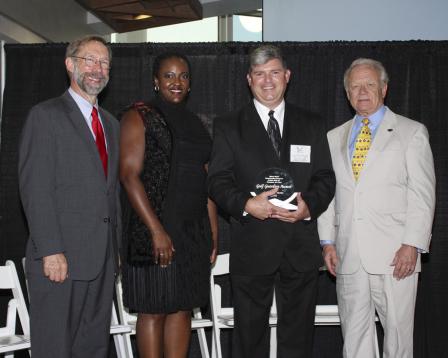 Pictured from left to right include: Stan Meiburg, Acting Deputy Administrator for EPA; Heather McTeer Toney, EPA Regional Administrator for Region 4; Travis Osbourne, Environmental Manager at Holcim, Inc.; and Ron Curry, EPA Regional Administrator for Region 6
Pictured from left to right include: Stan Meiburg, Acting Deputy Administrator for EPA; Heather McTeer Toney, EPA Regional Administrator for Region 4; Travis Osbourne, Environmental Manager at Holcim, Inc.; and Ron Curry, EPA Regional Administrator for Region 6
Holcim, Inc.
Theodore, AL
In 1999, a storm-water management program was initiated to eliminate storm water discharges into the Theodore Industrial Canal. Prior to this project, a tremendous amount of municipal water was being used for process gas conditioning and approximately 88 million gallons of captured storm water was being discharged to the Theodore Industrial Canal. This problem has since been eliminated, this self-sustaining project has resulted in 100% of the collected storm water from the plant site being utilized as process conditioning water, rather than being discharged into the Theodore Industrial Canal.
1st Place Youth Environmental Education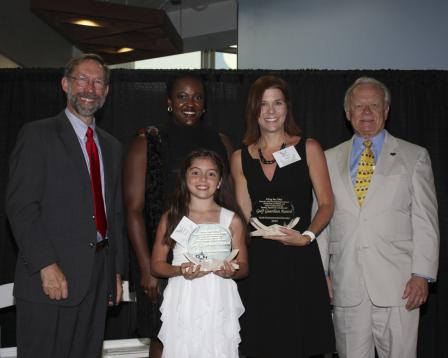 Pictured from left to right include: Stan Meiburg, Acting Deputy Administrator for EPA; Heather McTeer Toney, EPA Regional Administrator for Region 4; Cory Diaz, student at Bay Point Elementary; Renee Hale, Bay Point Elementary Gifted Teacher; and Ron Curry, EPA Regional Administrator for Region 6
Pictured from left to right include: Stan Meiburg, Acting Deputy Administrator for EPA; Heather McTeer Toney, EPA Regional Administrator for Region 4; Cory Diaz, student at Bay Point Elementary; Renee Hale, Bay Point Elementary Gifted Teacher; and Ron Curry, EPA Regional Administrator for Region 6
Utag for iTAG
Bay Point Elementary School
St. Petersburg, FL
After learning about sea turtle tracking from class discussions, and wanting to do something to help ocean animals, eight-year old Cory Diaz decided she would raise money to support iTAG as her gifted class community service project at Bay Point Elementary located in St. Petersburg, Florida.
Cory started a campaign to put, as she says, the “U” and ‘me” in iTAG. Cory creating an artistic logo that has been issued in the form of car magnets to more than 500 people educated about and supportive of iTAG. Initially, awareness and fundraising took the form of in-person solicitations, later with the support of Gulf iTAG Chair, Dr. Sue Lowerre-Barbieri, and OTN Executive Director, Dr. Fred Whoriskey, the outreach campaign rapidly expanded regionally, into Canada, and globally via OTNs efforts.
1st Place Environmental Justice/Cultural Diversity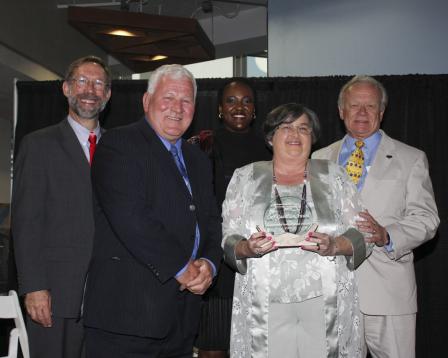 Pictured from left to right include: Stan Meiburg, Acting Deputy Administrator for EPA; David Gauthe, Organizer of Bayou Interfaith Shared Community Organizing, Inc.; Heather McTeer Toney, EPA Regional Administrator for Region 4; Sharon Gauthe, Director of Bayou Interfaith Shared Community Organizing, Inc.; and Ron Curry, EPA Regional Administrator for Region 6
Pictured from left to right include: Stan Meiburg, Acting Deputy Administrator for EPA; David Gauthe, Organizer of Bayou Interfaith Shared Community Organizing, Inc.; Heather McTeer Toney, EPA Regional Administrator for Region 4; Sharon Gauthe, Director of Bayou Interfaith Shared Community Organizing, Inc.; and Ron Curry, EPA Regional Administrator for Region 6
Bayou Interfaith Shared Community Organizing, Inc. (BISCO)
Thibodaux, LA
BISCO began an informal environmental education and advocacy project to have the Gulf Coast acknowledged as a “Regional Environmental Justice Community,” to build awareness of the role environmental injustice plays in the impacts Gulf Coast communities face. BISCO grew their efforts through social media and special events, which led to increased community organization to address the systemic causes of these injustices and build strong, just and healthy communities for the future. While the diverse population of the Gulf Coast faces land loss, sea level rise, and other environmental hardships, this project gave residents an important tool in understanding their circumstances and empowers them to build capacity to protect their own cultures.
1st Place Civic/Non-Profit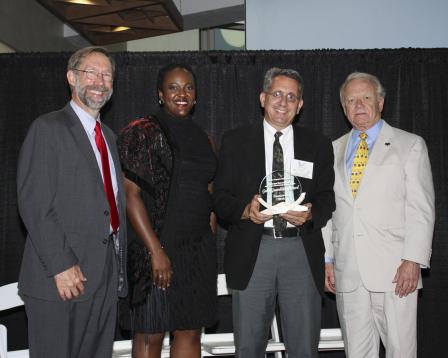 Pictured from left to right include: Stan Meiburg, Acting Deputy Administrator for EPA; Heather McTeer Toney, EPA Regional Administrator for Region 4; David Perkes, Director of Gulf Coast Community Design Studio; and Ron Curry, EPA Regional Administrator for Region 6
Pictured from left to right include: Stan Meiburg, Acting Deputy Administrator for EPA; Heather McTeer Toney, EPA Regional Administrator for Region 4; David Perkes, Director of Gulf Coast Community Design Studio; and Ron Curry, EPA Regional Administrator for Region 6
Bayou Auguste Restoration
Mississippi State University’s Gulf Coast Community Design Studio
Biloxi, MS
In 2009, the Mississippi State University’s Gulf Community Design Studio (GCCDS) worked to produce neighborhood plans for East Biloxi, a community that has been working to recover since the devastation caused by Hurricane Katrina. GCCDS began the project with elementary student environmental education activities and later combined these activities with community meetings to engage the residents in the project. The goals of the project were to restore and expand the natural habitat, to make a beautiful natural place free of invasive species and litter, to provide public access and learning opportunities, and to increase local environmental stewardship.
1st Place Individual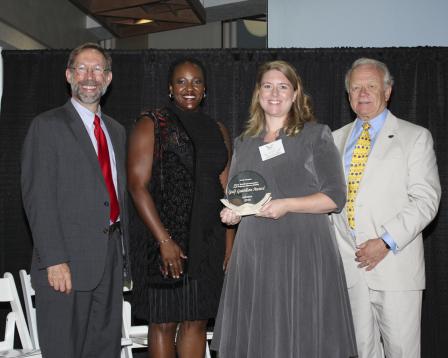 Pictured from left to right include: Stan Meiburg, Acting Deputy Administrator for EPA; Heather McTeer Toney, EPA Regional Administrator for Region 4; Tracie Sempier, MS-AL Sea Grant Consortium and Gulf of Mexico Alliance; and Ron Curry, EPA Regional Administrator for Region 6
Pictured from left to right include: Stan Meiburg, Acting Deputy Administrator for EPA; Heather McTeer Toney, EPA Regional Administrator for Region 4; Tracie Sempier, MS-AL Sea Grant Consortium and Gulf of Mexico Alliance; and Ron Curry, EPA Regional Administrator for Region 6
Tracie Sempier
MS/AL Sea Gran Consortium & Gulf of Mexico Alliance
Biloxi, MS
Since 2008, Tracie Sempier has been a driver for the development of one of the most influential programs for coastal resilience planning in the Gulf of Mexico. In her roles with Mississippi-Alabama Sea Grant Consortium and the Gulf of Mexico Alliance, she has helped inform Gulf coastal communities about the risks posed by coastal hazards, and has helped connect those communities to resources and assistance using a unique, hands-on approach to outreach. Overall, Tracie has worked to decrease the negative impacts of coastal storms on communities, the environment, and natural resources across the region.
1st Place Bi-National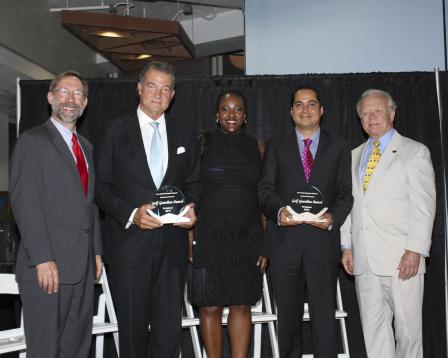 Pictured from left to right include: Stan Meiburg, Acting Deputy Administrator for EPA; Andelmo Estandía Colom, CEO of Acuario de Veracruz; Heather McTeer Toney, EPA Regional Administrator for Region 4; Victor Alvarado Martínez, Secretary of State, Veracruz State Environmental Ministry; and Ron Curry, EPA Regional Administrator for Region 6
Pictured from left to right include: Stan Meiburg, Acting Deputy Administrator for EPA; Andelmo Estandía Colom, CEO of Acuario de Veracruz; Heather McTeer Toney, EPA Regional Administrator for Region 4; Victor Alvarado Martínez, Secretary of State, Veracruz State Environmental Ministry; and Ron Curry, EPA Regional Administrator for Region 6
Sea Turtle Protection Program
Veracruz Aquarium
Veracruz, Mexico
The Kemp’s Ridley sea turtles are the most endangered and vulnerable species currently protected by both Mexican and American laws. In the state of Veracruz there are many important nesting areas, boasting an average of 1,500 nests per season throughout the state. Furthermore, by institutions sharing information, both countries can monitor where feeding occurs, determine the human activity in the area, and to what extent it directly or indirectly impacts the resources.
1st Place Partnerships Pictured from left to right include: Stan Meiburg, Acting Deputy Administrator for EPA; Heather McTeer Toney, EPA Regional Administrator for Region 4; Roberta Swann, Director of Mobile Bay National Estuary Program; Ron Curry, EPA Regional Administrator for Region 6; and Emery Baya, Senior Vice-President of Thompson Engineering
Pictured from left to right include: Stan Meiburg, Acting Deputy Administrator for EPA; Heather McTeer Toney, EPA Regional Administrator for Region 4; Roberta Swann, Director of Mobile Bay National Estuary Program; Ron Curry, EPA Regional Administrator for Region 6; and Emery Baya, Senior Vice-President of Thompson Engineering
Joe’s Branch Step Pool Storm Conveyance System
Thompson Engineering, Inc. & Mobile Bay National Estuary Program
Mobile, AL
ADEM had previously identified Joe’s Branch as impaired due to habitat impacts caused by erosion and sedimentation due to urbanization. This project was unique in bringing together disparate interests including Alabama Department of Transportation (ALDOT), Alabama Department of Conservation and Natural Resources (ADCNR), Geological Survey of Alabama (GSA), City of Daphne, City of Spanish Fort, Baldwin County, and Westminster Village- a private land owner, and an EPA-supported program to solve a drainage basin problem to the benefit of all. Water quality is improved using a sand/woodchip mixture beneath the primary flow channel to retain and filter lower flows.
Second Place Gulf Guardian Winners
2nd Place Business/Industry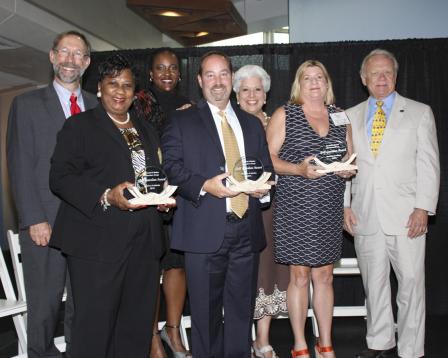 Pictured from left to right include: Stan Meiburg, Acting Deputy Administrator for EPA; Thelma Coleman, Louisiana One Call; Heather McTeer Toney, EPA Regional Administrator for Region 4; George Munro, Spectra Energy; Nelda Martinez, Mayor of Corpus Christi, TX, Susie Richmond, Kinetica Energy Express; and Ron Curry, EPA Regional Administrator for Region 6
Pictured from left to right include: Stan Meiburg, Acting Deputy Administrator for EPA; Thelma Coleman, Louisiana One Call; Heather McTeer Toney, EPA Regional Administrator for Region 4; George Munro, Spectra Energy; Nelda Martinez, Mayor of Corpus Christi, TX, Susie Richmond, Kinetica Energy Express; and Ron Curry, EPA Regional Administrator for Region 6
GoM Energy Infrastructure Protection through Port Vision Technology and Mariner Education
Coastal and Marine Operations Group
Houma, LA
The Coastal and Marine Operations Group educates mariners in the Gulf of Mexico about working safely around energy infrastructure to prevent oil spills. Through grants from the U.S. Department of Transportation’s Pipeline and Hazardous Materials Safety Administration, the Coastal and Marine Operators Group is using technology called geofencing to prevent oil spills. The system works to monitor activity near pipelines and warn vessels against dropping anchor and potentially striking a pipeline and causing a spill.
2nd Place Youth Environmental Education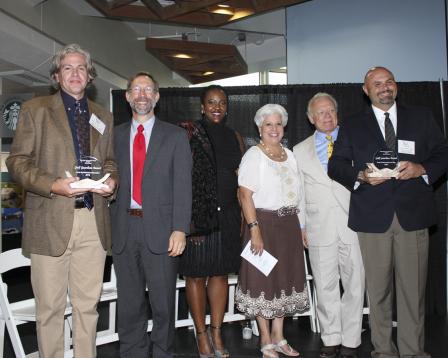 Pictured from left to right include: Matt Benoit, Plant Materials Coordinator at Barataria-Terrebonne National Estuary Program; Stan Meiburg, Acting Deputy Administrator for EPA; Heather McTeer Toney, EPA Regional Administrator for Region 4; Nelda Martinez, Mayor of Corpus Christi, TX, Ron Curry, EPA Regional Administrator for Region 6; and Joseph Dantin, Nichols State University
Pictured from left to right include: Matt Benoit, Plant Materials Coordinator at Barataria-Terrebonne National Estuary Program; Stan Meiburg, Acting Deputy Administrator for EPA; Heather McTeer Toney, EPA Regional Administrator for Region 4; Nelda Martinez, Mayor of Corpus Christi, TX, Ron Curry, EPA Regional Administrator for Region 6; and Joseph Dantin, Nichols State University
Growing Restoration Roots
Barataria-Terrebonne National Estuary Program
Thibodaux, LA
The Barataria-Terrebonne National Estuary Program (BTNEP) is engaged in a unique education program that brings students from around the nation to help expand the type and diversity of wetland plants that are used in coastal restoration in Louisiana. Mostly college students (80%) come to the BTNEP to learn to pot plants, identify stages of growth for plants, and then go out into the habitat to plant older varieties on wetland restoration projects. Additionally, students have been instrumental in building shade houses, greenhouses, and aquatic vegetation ponds.
2nd Place Environmental Justice/Cultural Diversity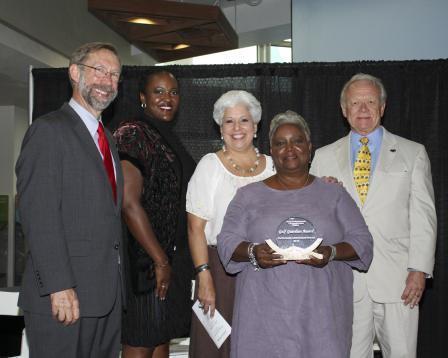 Pictured from left to right include: Stan Meiburg, Acting Deputy Administrator for EPA; Heather McTeer Toney, EPA Regional Administrator for Region 4; Nelda Martinez, Mayor of Corpus Christi, TX, Claudette Walker, on behalf of the Center for Environmental & Economic Justice; and Ron Curry, EPA Regional Administrator for Region 6
Pictured from left to right include: Stan Meiburg, Acting Deputy Administrator for EPA; Heather McTeer Toney, EPA Regional Administrator for Region 4; Nelda Martinez, Mayor of Corpus Christi, TX, Claudette Walker, on behalf of the Center for Environmental & Economic Justice; and Ron Curry, EPA Regional Administrator for Region 6
Center for Environmental and Economic Justice
Biloxi, MS
For over 20 years, the Center for Environmental & Economic Justice (CEEJ) has been involved in the Environmental Justice (EJ) movement by working to eliminate environmental health hazards and promote economic sustainability through community education, hazard control training, and by engaging in social justice issues that affect African-Americans and other impacted ethnicities in Mississippi. Their mission and approach is to eradicate environmental, social, and economic injustices where those within these communities work, live, play and worship. CEEJ has successfully brought the community in as accountable, responsible, contributors in their efforts to prevent pollution in our homes and neighborhoods, thus resulting in creating awareness among the stakeholders and educating them on the various environmental hazards.
2nd Place Civic/Non-Profit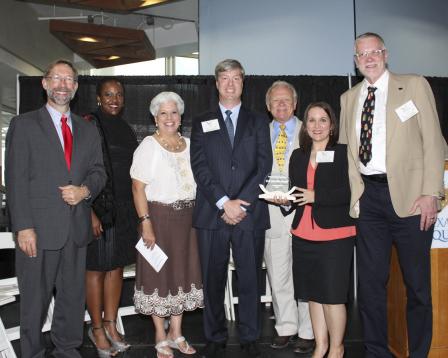 Pictured from left to right include: Stan Meiburg, Acting Deputy Administrator for EPA; Heather McTeer Toney, EPA Regional Administrator for Region 4; Nelda Martinez, Mayor of Corpus Christi, TX, Bob Stokes, President of Galveston Bay Foundation; Ron Curry, EPA Regional Administrator for Region 6; Courtney Smith, Vice-President of Operations at Galveston Bay Foundation; and Timothy Love, Galveston Bay Foundation Board Chair
Pictured from left to right include: Stan Meiburg, Acting Deputy Administrator for EPA; Heather McTeer Toney, EPA Regional Administrator for Region 4; Nelda Martinez, Mayor of Corpus Christi, TX, Bob Stokes, President of Galveston Bay Foundation; Ron Curry, EPA Regional Administrator for Region 6; Courtney Smith, Vice-President of Operations at Galveston Bay Foundation; and Timothy Love, Galveston Bay Foundation Board Chair
Galveston Bay Foundation
Webster, TX
Founded in 1987 by citizens concerned about the impact of several large projects on Galveston Bay, GBF is a nonprofit organization on the upper Texas coast with the mission to preserve, protect, and enhance the natural resources of Galveston Bay for present users and for posterity. Through 28 years of service, GBF’s strength has been its ability to balance diverse interests to address issues and concerns related to Galveston Bay. Its programs in advocacy, conservation, education, and research work to ensure Galveston Bay remains a beautiful and productive place for generations to come.
2nd Place Individual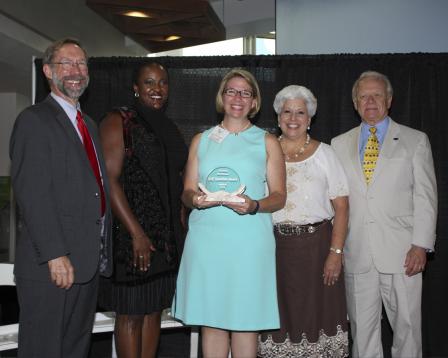 Pictured from left to right include: Stan Meiburg, Acting Deputy Administrator for EPA; Heather McTeer Toney, EPA Regional Administrator for Region 4; Casi Callaway, Mobile Baykeeper; Nelda Martinez, Mayor of Corpus Christi, TX, and Ron Curry, EPA Regional Administrator for Region 6
Pictured from left to right include: Stan Meiburg, Acting Deputy Administrator for EPA; Heather McTeer Toney, EPA Regional Administrator for Region 4; Casi Callaway, Mobile Baykeeper; Nelda Martinez, Mayor of Corpus Christi, TX, and Ron Curry, EPA Regional Administrator for Region 6
Casi Callaway
Mobile Baykeeper
Mobile, AL
Casi Callaway has been an advocate for protecting and preserving the Gulf of Mexico for 25 years. As Baykeeper, she has coordinated advocacy, educated the public, organized the community, and researched pollution issues on local, regional and national platforms. As the advocate for the Mobile Bay Watershed, specifically focused on Mobile and Baldwin Counties in Alabama, Casi works on such broad ranging issues as sewage, air toxics, mercury exposure, permit violations, industrial growth, and other public health protection issues.
2nd Place Bi-National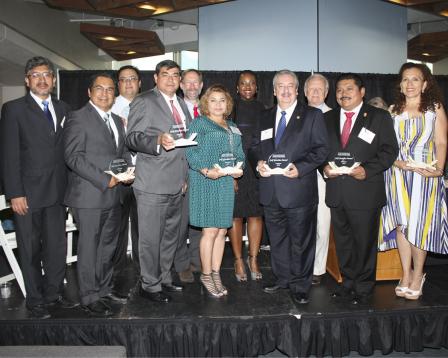 Pictured from left to right include: Porfirio Alvarez, Executive Secretary CiiMAR; Surgio Jiménez, Director of CIDIPORT; David Cuéllar, Technological University of Matamoros; Jose Manuel Pina, President Universidad Juárez Autónoma de Tabasco; Stan Meiburg, Acting Deputy Administrator for EPA; Gabriela Hernández, Vinculación del CIDIPIORT; Heather McTeer Toney, EPA Regional Administrator for Region 4; Enrique Ettiene, President Universidad Autónoma de Tamaulipas; Ron Curry, EPA Regional Administrator for Region 6; José Antonio, President Universidat Autónoma del Carmen; Ruiz Hernández, Ana Lerma
Pictured from left to right include: Porfirio Alvarez, Executive Secretary CiiMAR; Surgio Jiménez, Director of CIDIPORT; David Cuéllar, Technological University of Matamoros; Jose Manuel Pina, President Universidad Juárez Autónoma de Tabasco; Stan Meiburg, Acting Deputy Administrator for EPA; Gabriela Hernández, Vinculación del CIDIPIORT; Heather McTeer Toney, EPA Regional Administrator for Region 4; Enrique Ettiene, President Universidad Autónoma de Tamaulipas; Ron Curry, EPA Regional Administrator for Region 6; José Antonio, President Universidat Autónoma del Carmen; Ruiz Hernández, Ana Lerma
Consorcio de Institucioned de Investigación Marina del Golfo de México y del Caribe (CiiMAR)
Tabasco, Mexico
In 2011, Consorcio de Instituciones de Investigación Marina del Golfo de México y del Caribe (CiiMAR) began as a concept of how to bring marine science institutions in the Mexico region of the Gulf of Mexico together in a network that would benefit the members and important issues for Gulf of Mexico citizens. The mission is fostering collaboration among the members in relevant marine science and knowledge contributing to best management practices and sustainable development of the region supporting the ecosystem and economic health of the Gulf of Mexico. The Consortium is recognized as a high level, scientific authority organization committed to strengthening the sustainable development and integral well-being of the Gulf of Mexico and the Caribbean.
2nd Place Partnerships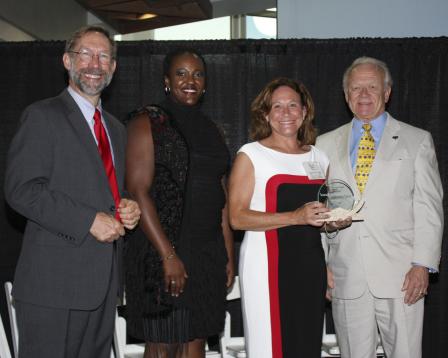 Pictured from left to right include: Stan Meiburg, Acting Deputy Administrator for EPA; Heather McTeer Toney, EPA Regional Administrator for Region 4; Alma Robichaux, Education/Outreach Coordinator at Barataria-Terrebonne National Estuary Program; and Ron Curry, EPA Regional Administrator for Region 6
Pictured from left to right include: Stan Meiburg, Acting Deputy Administrator for EPA; Heather McTeer Toney, EPA Regional Administrator for Region 4; Alma Robichaux, Education/Outreach Coordinator at Barataria-Terrebonne National Estuary Program; and Ron Curry, EPA Regional Administrator for Region 6
Bayou LaFourche Clean Up
Barataria-Terrebonne National Estuary Program
Thibodaux, LA
Through the Bayou Lafourche Cleanup, this increasingly popular event raises awareness about litter and EPA’s Trash Free Waters goals. The project aims to change citizens’ behavior by recording the volume and types of materials retrieved from water annually to assess likely sources of litter. Reducing the amount of trash and litter entering waterways helps improve and protect people’s health and the health and productivity of the Gulf itself.
Third Place Gulf Guardian Winners
3rd Place Environmental Justice/Cultural Diversity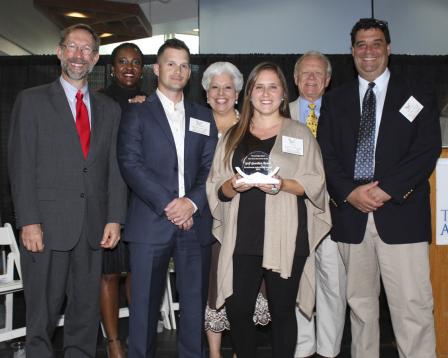 Pictured from left to right include: Stan Meiburg, Acting Deputy Administrator for EPA; Heather McTeer Toney, EPA Regional Administrator for Region 4; Tysman Charpentier, Founding Member; Nelda Martinez, Mayor of Corpus Christi, TX, Misty McElroy, Founding Member; Ron Curry, EPA Regional Administrator for Region 6; and Quenton Fontenot, Founding Member
Pictured from left to right include: Stan Meiburg, Acting Deputy Administrator for EPA; Heather McTeer Toney, EPA Regional Administrator for Region 4; Tysman Charpentier, Founding Member; Nelda Martinez, Mayor of Corpus Christi, TX, Misty McElroy, Founding Member; Ron Curry, EPA Regional Administrator for Region 6; and Quenton Fontenot, Founding Member
“We Love Cajun Music”
Cajun Music Preservation Society
Thibodaux, LA
The Cajun Music Preservation Society has a mission to promote, preserve, and enhance the awareness and appreciation of traditional Cajun music in Southeastern Louisiana which often describes the unique habitat and lifestyles of coastal communities. With many changes in coastal habitat happening all around us this organization uses music to reach out to people to connect with habitat. Cajun music reminds people of the value of healthy and productive wetlands.
3rd Place Civic/Non-Profit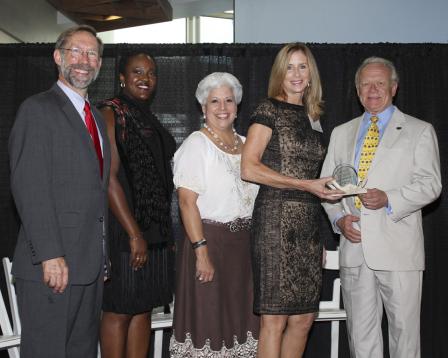 Pictured from left to right include: Stan Meiburg, Acting Deputy Administrator for EPA; Heather McTeer Toney, EPA Regional Administrator for Region 4; Nelda Martinez, Mayor of Corpus Christi, TX, Lori Traweek, President of Texas Conservation Fund; and Ron Curry, EPA Regional Administrator for Region 6
Pictured from left to right include: Stan Meiburg, Acting Deputy Administrator for EPA; Heather McTeer Toney, EPA Regional Administrator for Region 4; Nelda Martinez, Mayor of Corpus Christi, TX, Lori Traweek, President of Texas Conservation Fund; and Ron Curry, EPA Regional Administrator for Region 6
Rivers, Lakes, Bays ‘n Bayous Trash Bash
Texas Conservation Fund & Houston-Galveston Area Council
Houston, TX
The River, Lakes, Bays ‘N Bayous Trash Bash® is the largest, single-day, waterway cleanup event in Texas. In 2014, Trash Bash held its 21st consecutive cleanup event at 16 sites across the region in continuation of its mission to promote environmental stewardship of the Galveston Bay Watershed by removing litter/debris and educating volunteers about positive water behaviors.
During the event, 4,622 volunteers cleaned 157 miles of shoreline, collected 37.6 tons of trash, and recycled 2,858 pounds of materials.
3rd Place Individual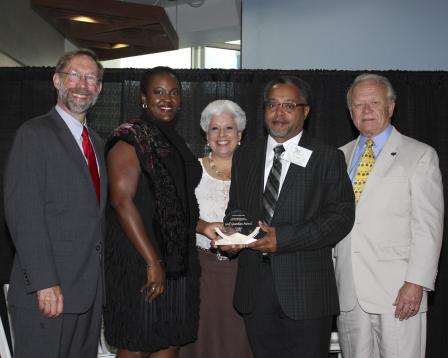 Pictured from left to right include: Stan Meiburg, Acting Deputy Administrator for EPA; Heather McTeer Toney, EPA Regional Administrator for Region 4; Nelda Martinez, Mayor of Corpus Christi, TX, Dr. Richard Gragg, Florida A & M University; and Ron Curry, EPA Regional Administrator for Region 6
Pictured from left to right include: Stan Meiburg, Acting Deputy Administrator for EPA; Heather McTeer Toney, EPA Regional Administrator for Region 4; Nelda Martinez, Mayor of Corpus Christi, TX, Dr. Richard Gragg, Florida A & M University; and Ron Curry, EPA Regional Administrator for Region 6
Richard Gragg, PhD
Florida A& M University
Tallahassee, FL
Dr. Gragg has actively promoted environmental justice as a member and in partnership with more than a dozen public and private entities including Florida Department of Environmental Protection- Community Environmental Health Advisory Board, Florida Department of Health, Executive Council and Health and Research Subcommittee, and the National Environmental Justice Advisory Council- US Environmental Protection Agency. In collaboration with others, he has secured over $59 million by identifying and pursuing sources of grant funding to conduct environmental science, justice, health and policy research, developing proposals for state and federal agencies and foundations. Overall, due to his exceptional passion and commitment, he has served above and beyond the call of duty to educate and train students from underrepresented groups and conduct research in environmental science and policy with an emphasis in environmental justice.
3rd Place Partnerships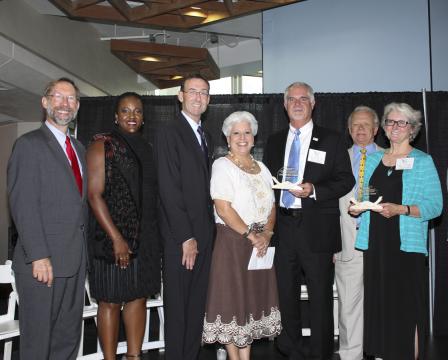 Pictured from left to right include: Stan Meiburg, Acting Deputy Administrator for EPA; Heather McTeer Toney, EPA Regional Administrator for Region 4; Jeff Stewart, Senior Manager at The Mosaic Company; Nelda Martinez, Mayor of Corpus Christi, TX, Jeff Benoit, President of Restore America’s Estuaries; Ron Curry, EPA Regional Administrator for Region 6; and Holly Greening, Director of Tampa Bay Estuary Program
Pictured from left to right include: Stan Meiburg, Acting Deputy Administrator for EPA; Heather McTeer Toney, EPA Regional Administrator for Region 4; Jeff Stewart, Senior Manager at The Mosaic Company; Nelda Martinez, Mayor of Corpus Christi, TX, Jeff Benoit, President of Restore America’s Estuaries; Ron Curry, EPA Regional Administrator for Region 6; and Holly Greening, Director of Tampa Bay Estuary Program
Tampa Bay Environmental Restoration Fund
Tampa Bay Estuary Program and Restore America’s Estuaries
St. Petersburg, FL
In 2012, the Tampa Bay Environmental Restoration Fund (TBERF) was initiated by the National Fish and Wildlife Foundation with the goal providing funding through a competitive application process for projects that will protect, restore or enhance the natural resources of Tampa Bay and its contributing watershed. Each proposal is required to have a dollar-for-dollar match, further leveraging the impact of the grant funds. Furthermore, the criteria for competitive applications for TBERF awards include projects that develop community stewardship through hands-on participation, volunteerism and/or innovative education and outreach associated with the project.
